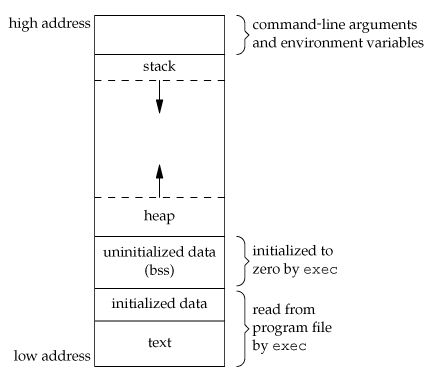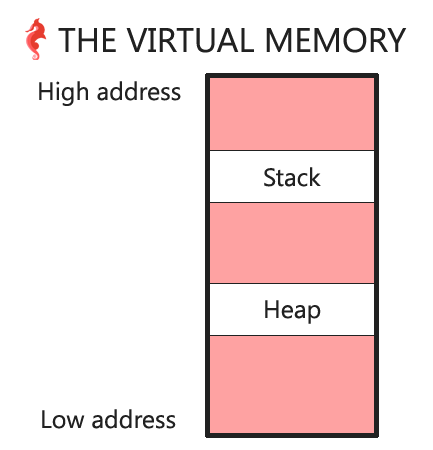阅记-计算机系统-Hack the Virtual Memory 2: drawing the VM diagram
link: Hack the Virtual Memory: drawing the VM diagram
We previously talked about what you could find in the virtual memory of a process, and where you could find it. Today, we will try to “reconstruct” (part of) the following diagram by making our process print addresses of various elements of the program.

The stack
The first thing we want to locate in our diagram is the stack. We know that in C, local variables are located on the stack. So if we print the address of a local variable, it should give us an idea on where we would find the stack in the virtual memory. Let's use this program (main-1.c) to find out:
#include <stdlib.h>
#include <stdio.h>
#include <string.h>
int main(void)
{
int a;
printf("Address of a: %p\n", (void *)&a);
return (EXIT_SUCCESS);
}
$ gcc -Wall -Wextra -pedantic -Werror main-0.c -o 0
$ ./0
Address of a: 0x7ffd14b8bd9c
2$
This will be our first point of reference when we will compare other elements' addresses.
The heap
The heap is used when you malloc space for your variables. Let's add a line to use malloc and see where the memory address returned by malloc is located (main-1.c):
#include <stdlib.h>
#include <stdio.h>
#include <string.h>
int main(void)
{
int a;
void *p;
printf("Address of a: %p\n", (void *)&a);
p = malloc(98);
if (p == NULL) {
fprintf(stderr, "Can't malloc\n");
return (EXIT_FAILURE);
}
printf("Allocated space in the heap: %p\n", p);
return (EXIT_SUCCESS);
}
$ gcc -Wall -Wextra -pedantic -Werror main-1.c -o 1
$ ./1
Address of a: 0x7ffd4204c554
Allocated space in the heap: 0x901010
It's now clear that the heap (0x901010) is way below the stack (0x7ffd4204c554).
+++
diagram v1
At this point we can already draw this diagram:

The executable
Your program is also in the virtual memory. If we print the address of the main function, we should have an idea of where the program is located compared to the stack and the heap. Let's see if we find it below the heap as expected (main-2.c):
#include <stdlib.h>
#include <stdio.h>
#include <string.h>
int main(void)
{
int a;
void *p;
printf("Address of a: %p\n", (void *)&a);
p = malloc(98);
if (p == NULL) {
fprintf(stderr, "Can't malloc\n");
return (EXIT_FAILURE);
}
printf("Allocated space in the heap: %p\n", p);
printf("Address of function main: %p\n", (void *)main);
return (EXIT_SUCCESS);
}
$ gcc -Wall -Wextra -Werror main-2.c -o 2
$ ./2
Address of a: 0x7ffdced37d74
Allocated space in the heap: 0x2199010
Address of function main: 0x40060d
It seems that our program (0x40060d) is located below the heap (0x2199010), just as expected.
But let's make sure that this is the actual code of our program, and not some sort of pointer to another location. Let's disassemble our program 2 with objdump to look at the “memory address” of the main function:
$ objdump -M intel -j .text -d 2 | grep '<main>:' -A 5
000000000040060d <main>:
40060d: 55 push rbp
40060e: 48 89 e5 mov rbp,rsp
400611: 48 83 ec 10 sub rsp,0x10
400615: 48 8d 45 f4 lea rax,[rbp-0xc]
400619: 48 89 c6 mov rsi,rax
000000000040060d <main> -> we find the exact same address (0x40060d).
+++
If you still have any doubts, you can print the first bytes located at this address, to make sure they match the output of objdump (main-3.c):
点击查看代码
#include <stdlib.h>
#include <stdio.h>
#include <string.h>
int main(void)
{
int a;
void *p;
unsigned int i;
printf("Address of a: %p\n", (void *)&a);
p = malloc(98);
if (p == NULL) {
fprintf(stderr, "Can't malloc\n");
return (EXIT_FAILURE);
}
printf("Allocated space in the heap: %p\n", p);
printf("Address of function main: %p\n", (void *)main);
printf("First bytes of the main function:\n\t");
for (i = 0; i < 15; i++) {
printf("%02x ", ((unsigned char *)main)[i]);
}
printf("\n");
return (EXIT_SUCCESS);
}
$ gcc -Wall -Wextra -Werror main-3.c -o 3
$ objdump -M intel -j .text -d 3 | grep '<main>:' -A 5
000000000040064d <main>:
40064d: 55 push rbp
40064e: 48 89 e5 mov rbp,rsp
400651: 48 83 ec 10 sub rsp,0x10
400655: 48 8d 45 f0 lea rax,[rbp-0x10]
400659: 48 89 c6 mov rsi,rax
$ ./3
Address of a: 0x7ffeff0f13b0
Allocated space in the heap: 0x8b3010
Address of function main: 0x40064d
First bytes of the main function:
55 48 89 e5 48 83 ec 10 48 8d 45 f0 48 89 c6
$ echo "55 48 89 e5 48 83 ec 10 48 8d 45 f0 48 89 c6" | udcli -64 -x -o 40064d
000000000040064d 55 push rbp
000000000040064e 4889e5 mov rbp, rsp
0000000000400651 4883ec10 sub rsp, 0x10
0000000000400655 488d45f0 lea rax, [rbp-0x10]
0000000000400659 4889c6 mov rsi, rax
$
-> We can see that we print the same address and the same content. We are now triple sure this is our main function.
You can download the Udis86 Disassembler Library here.
diagram v2
Here is the updated diagram, based on what we have learned:

Command line arguments and environment variables
The main function can take arguments:
- The command line arguments
- the first argument of the
mainfunction (usually namedargcorac) is the number of command line arguments - the second argument of the
mainfunction (usually named argv orav) is an array of pointers to the arguments (C strings)
- the first argument of the
- The environment variables
- the third argument of the
mainfunction (usally named env orenvp) is an array of pointers to the environment variables (C strings)
- the third argument of the
Let's see where those elements stand in the virtual memory of our process (main-4.c):
#include <stdlib.h>
#include <stdio.h>
#include <string.h>
int main(int ac, char **av, char **env)
{
int a;
void *p;
int i;
printf("Address of a: %p\n", (void *)&a);
p = malloc(98);
if (p == NULL) {
fprintf(stderr, "Can't malloc\n");
return (EXIT_FAILURE);
}
printf("Allocated space in the heap: %p\n", p);
printf("Address of function main: %p\n", (void *)main);
printf("First bytes of the main function:\n\t");
for (i = 0; i < 15; i++) {
printf("%02x ", ((unsigned char *)main)[i]);
}
printf("\n");
printf("Address of the array of arguments: %p\n", (void *)av);
printf("Addresses of the arguments:\n\t");
for (i = 0; i < ac; i++) {
printf("[%s]:%p ", av[i], av[i]);
}
printf("\n");
printf("Address of the array of environment variables: %p\n", (void *)env);
printf("Address of the first environment variable: %p\n", (void *)(env[0]));
return (EXIT_SUCCESS);
}
$ gcc -Wall -Wextra -Werror main-4.c -o 4
$ ./4 Hello Holberton School!
Address of a: 0x7ffe7d6d8da0
Allocated space in the heap: 0xc8c010
Address of function main: 0x40069d
First bytes of the main function:
55 48 89 e5 48 83 ec 30 89 7d ec 48 89 75 e0
Address of the array of arguments: 0x7ffe7d6d8e98
Addresses of the arguments:
[./4]:0x7ffe7d6da373 [Hello]:0x7ffe7d6da377 [Holberton]:0x7ffe7d6da37d [School!]:0x7ffe7d6da387
Address of the array of environment variables: 0x7ffe7d6d8ec0
Address of the first environment variables:
[0x7ffe7d6da38f]:"XDG_VTNR=7"
[0x7ffe7d6da39a]:"XDG_SESSION_ID=c2"
[0x7ffe7d6da3ac]:"CLUTTER_IM_MODULE=xim"
$
These elements are above the stack as expected, but now we know the exact order: stack (0x7ffe7d6d8da0) < argv (0x7ffe7d6d8e98) < env (0x7ffe7d6d8ec0) < arguments (from 0x7ffe7d6da373 to 0x7ffe7d6da387 + 8 (8 = size of the string "school" + 1 for the '\0' char)) < environment variables (starting at 0x7ffe7d6da38f).
Actually, we can also see that all the command line arguments are next to each other in the memory, and also right next to the environment variables.
- are the argv and env arrays next to each other?
The array argv is 5 elements long (there were 4 arguments from the command line + 1 NULL element at the end (argv always ends with NULL to mark the end of the array)). Each element is a pointer to a char and since we are on a 64-bit machine, a pointer is 8 bytes (if you want to make sure, you can use the C operator sizeof() to get the size of a pointer). As a result our argv array is of size 5 * 8 = 40. 40 in base 10 is 0x28 in base 16. If we add this value to the address of the beginning of the array 0x7ffe7d6d8e98, we get… 0x7ffe7d6d8ec0 (The address of the env array)! So the two arrays are next to each other in memory.
- Is the first command line argument stored right after the env array?
In order to check this we need to know the size of the env array. We know that it ends with a NULL pointer, so in order to get the number of its elements we simply need to loop through it, checking if the “current” element is NULL. Here's the updated C code (main-5.c):
#include <stdlib.h>
#include <stdio.h>
#include <string.h>
int main(int ac, char **av, char **env)
{
int a;
void *p;
int i;
int size;
printf("Address of a: %p\n", (void *)&a);
p = malloc(98);
if (p == NULL) {
fprintf(stderr, "Can't malloc\n");
return (EXIT_FAILURE);
}
printf("Allocated space in the heap: %p\n", p);
printf("Address of function main: %p\n", (void *)main);
printf("First bytes of the main function:\n\t");
for (i = 0; i < 15; i++) {
printf("%02x ", ((unsigned char *)main)[i]);
}
printf("\n");
printf("Address of the array of arguments: %p\n", (void *)av);
printf("Addresses of the arguments:\n\t");
for (i = 0; i < ac; i++) {
printf("[%s]:%p ", av[i], av[i]);
}
printf("\n");
printf("Address of the array of environment variables: %p\n", (void *)env);
printf("Address of the first environment variables:\n");
for (i = 0; i < 3; i++) {
printf("\t[%p]:\"%s\"\n", env[i], env[i]);
}
/* size of the env array */
i = 0;
while (env[i] != NULL) {
i++;
}
i++; /* the NULL pointer */
size = i * sizeof(char *);
printf("Size of the array env: %d elements -> %d bytes (0x%x)\n", i, size, size);
return (EXIT_SUCCESS);
}
$ ./5 Hello Betty Holberton!
Address of a: 0x7ffc77598acc
Allocated space in the heap: 0x2216010
Address of function main: 0x40069d
First bytes of the main function:
55 48 89 e5 48 83 ec 40 89 7d dc 48 89 75 d0
Address of the array of arguments: 0x7ffc77598bc8
Addresses of the arguments:
[./5]:0x7ffc7759a374 [Hello]:0x7ffc7759a378 [Betty]:0x7ffc7759a37e [Holberton!]:0x7ffc7759a384
Address of the array of environment variables: 0x7ffc77598bf0
Address of the first environment variables:
[0x7ffc7759a38f]:"XDG_VTNR=7"
[0x7ffc7759a39a]:"XDG_SESSION_ID=c2"
[0x7ffc7759a3ac]:"CLUTTER_IM_MODULE=xim"
Size of the array env: 62 elements -> 496 bytes (0x1f0)
$ bc
bc 1.06.95
Copyright 1991-1994, 1997, 1998, 2000, 2004, 2006 Free Software Foundation, Inc.
This is free software with ABSOLUTELY NO WARRANTY.
For details type `warranty'.
obase=16
ibase=16
1F0+7FFC77598BF0
7FFC77598DE0
-> 7FFC77598DE0 != (but still <) 0x7ffc7759a374. So the answer is no !
diagram v3
Let's update our diagram with what we learned.

/proc
Let's double check everything we found so far with /proc/[pid]/maps (man proc or refer to the first article in this series to learn about the proc filesystem if you don't know what it is).
Let's add a getchar() to our program so that we can look at its “/proc” (main-7.c):
#include <stdlib.h>
#include <stdio.h>
#include <string.h>
void f(void)
{
int a;
int b;
int c;
a = 98;
b = 1024;
c = a * b;
printf("[f] a = %d, b = %d, c = a * b = %d\n", a, b, c);
printf("[f] Adresses of a: %p, b = %p, c = %p\n", (void *)&a, (void *)&b, (void *)&c);
}
int main(int ac, char **av, char **env)
{
int a;
void *p;
int i;
int size;
printf("Address of a: %p\n", (void *)&a);
p = malloc(98);
if (p == NULL)
{
fprintf(stderr, "Can't malloc\n");
return (EXIT_FAILURE);
}
printf("Allocated space in the heap: %p\n", p);
printf("Address of function main: %p\n", (void *)main);
printf("First bytes of the main function:\n\t");
for (i = 0; i < 15; i++)
{
printf("%02x ", ((unsigned char *)main)[i]);
}
printf("\n");
printf("Address of the array of arguments: %p\n", (void *)av);
printf("Addresses of the arguments:\n\t");
for (i = 0; i < ac; i++)
{
printf("[%s]:%p ", av[i], av[i]);
}
printf("\n");
printf("Address of the array of environment variables: %p\n", (void *)env);
printf("Address of the first environment variables:\n");
for (i = 0; i < 3; i++)
{
printf("\t[%p]:\"%s\"\n", env[i], env[i]);
}
/* size of the env array */
i = 0;
while (env[i] != NULL)
{
i++;
}
i++; /* the NULL pointer */
size = i * sizeof(char *);
printf("Size of the array env: %d elements -> %d bytes (0x%x)\n", i, size, size);
f();
getchar();
return (EXIT_SUCCESS);
}
$ gcc -Wall -Wextra -Werror main-7.c -o 7
$ ./7 Rona is a Legend SRE
Address of a: 0x7fff16c8146c
Allocated space in the heap: 0x2050010
Address of function main: 0x400739
First bytes of the main function:
55 48 89 e5 48 83 ec 40 89 7d dc 48 89 75 d0
Address of the array of arguments: 0x7fff16c81568
Addresses of the arguments:
[./7]:0x7fff16c82376 [Rona]:0x7fff16c8237a [is]:0x7fff16c8237f [a]:0x7fff16c82382 [Legend]:0x7fff16c82384 [SRE]:0x7fff16c8238b
Address of the array of environment variables: 0x7fff16c815a0
Address of the first environment variables:
[0x7fff16c8238f]:"XDG_VTNR=7"
[0x7fff16c8239a]:"XDG_SESSION_ID=c2"
[0x7fff16c823ac]:"CLUTTER_IM_MODULE=xim"
Size of the array env: 62 elements -> 496 bytes (0x1f0)
[f] a = 98, b = 1024, c = a * b = 100352
[f] Adresses of a: 0x7fff16c81424, b = 0x7fff16c81428, c = 0x7fff16c8142c
julien@holberton:~$ ps aux | grep "./7" | grep -v grep
julien 5788 0.0 0.0 4336 628 pts/8 S+ 18:04 0:00 ./7 Rona is a Legend SRE
julien@holberton:~$ cat /proc/5788/maps
00400000-00401000 r-xp 00000000 08:01 171828 /home/julien/holberton/w/hackthevm2/7
00600000-00601000 r--p 00000000 08:01 171828 /home/julien/holberton/w/hackthevm2/7
00601000-00602000 rw-p 00001000 08:01 171828 /home/julien/holberton/w/hackthevm2/7
02050000-02071000 rw-p 00000000 00:00 0 [heap]
7f68caa1c000-7f68cabd6000 r-xp 00000000 08:01 136253 /lib/x86_64-linux-gnu/libc-2.19.so
7f68cabd6000-7f68cadd6000 ---p 001ba000 08:01 136253 /lib/x86_64-linux-gnu/libc-2.19.so
7f68cadd6000-7f68cadda000 r--p 001ba000 08:01 136253 /lib/x86_64-linux-gnu/libc-2.19.so
7f68cadda000-7f68caddc000 rw-p 001be000 08:01 136253 /lib/x86_64-linux-gnu/libc-2.19.so
7f68caddc000-7f68cade1000 rw-p 00000000 00:00 0
7f68cade1000-7f68cae04000 r-xp 00000000 08:01 136229 /lib/x86_64-linux-gnu/ld-2.19.so
7f68cafe8000-7f68cafeb000 rw-p 00000000 00:00 0
7f68cafff000-7f68cb003000 rw-p 00000000 00:00 0
7f68cb003000-7f68cb004000 r--p 00022000 08:01 136229 /lib/x86_64-linux-gnu/ld-2.19.so
7f68cb004000-7f68cb005000 rw-p 00023000 08:01 136229 /lib/x86_64-linux-gnu/ld-2.19.so
7f68cb005000-7f68cb006000 rw-p 00000000 00:00 0
7fff16c62000-7fff16c83000 rw-p 00000000 00:00 0 [stack]
7fff16d07000-7fff16d09000 r--p 00000000 00:00 0 [vvar]
7fff16d09000-7fff16d0b000 r-xp 00000000 00:00 0 [vdso]
ffffffffff600000-ffffffffff601000 r-xp 00000000 00:00 0 [vsyscall]
julien@holberton:~$
Let's check a few things:
- The stack starts at
7fff16c62000and ends at7fff16c83000. Our variables are all inside this region (0x7fff16c8146c,0x7fff16c81424,0x7fff16c81428,0x7fff16c8142c) - The heap starts at
02050000and ends at02071000. Our allocated memory is in there (0x2050010)
+++
- Our code (the
mainfunction) is located at address0x400739, so in the following region:
It comes from the file00400000-00401000 r-xp 00000000 08:01 171828 /home/julien/holberton/w/hackthevm2/7/home/julien/holberton/w/hackthevm2/7(our executable) and this region has execution permissions, which also makes sense. - The arguments and environment variables (from
0x7fff16c81568to0x7fff16c8238f+0x1f0) are located in the region starting at7fff16c62000and ending at7fff16c83000… the stack! So they are IN the stack, not outside the stack.
diagram release

Outro
小结
- stack: 打印main函数第一个局部变量地址
- heap : 打印第一个malloc返回地址
- 代码段: 打印main函数地址
- arguments and environment variables: 最后从/proc确认其也属于[stack]
Files
This repo contains the source code (main-X.c files) for programs created in this tutorial.
本文来自博客园,作者:LiYanbin,转载请注明原文链接:https://www.cnblogs.com/stellar-liyanbin/p/18861382




 浙公网安备 33010602011771号
浙公网安备 33010602011771号